Managerial Accounting: Financial Analysis & Floppy Disc Inc. Report
VerifiedAdded on 2023/06/08
|11
|1403
|496
Report
AI Summary
This document presents a detailed solution to a managerial accounting assignment, encompassing several key areas of financial analysis. It includes an income statement for Floppy Disc Inc., segmented by product lines (DVD and Blu-Ray), utilizing a contribution format to assess profitability. The a...
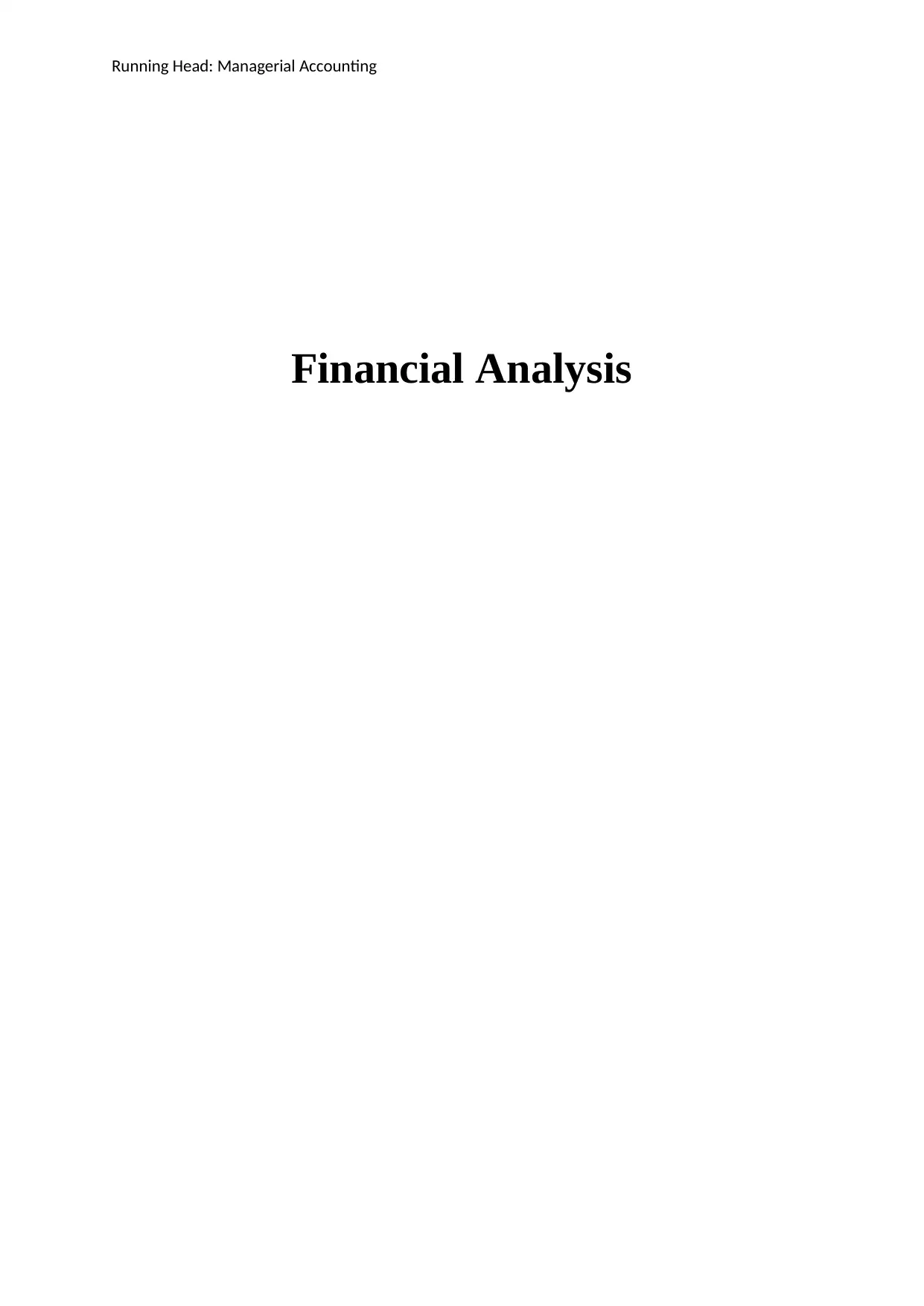
Running Head: Managerial Accounting
Financial Analysis
Financial Analysis
Paraphrase This Document
Need a fresh take? Get an instant paraphrase of this document with our AI Paraphraser
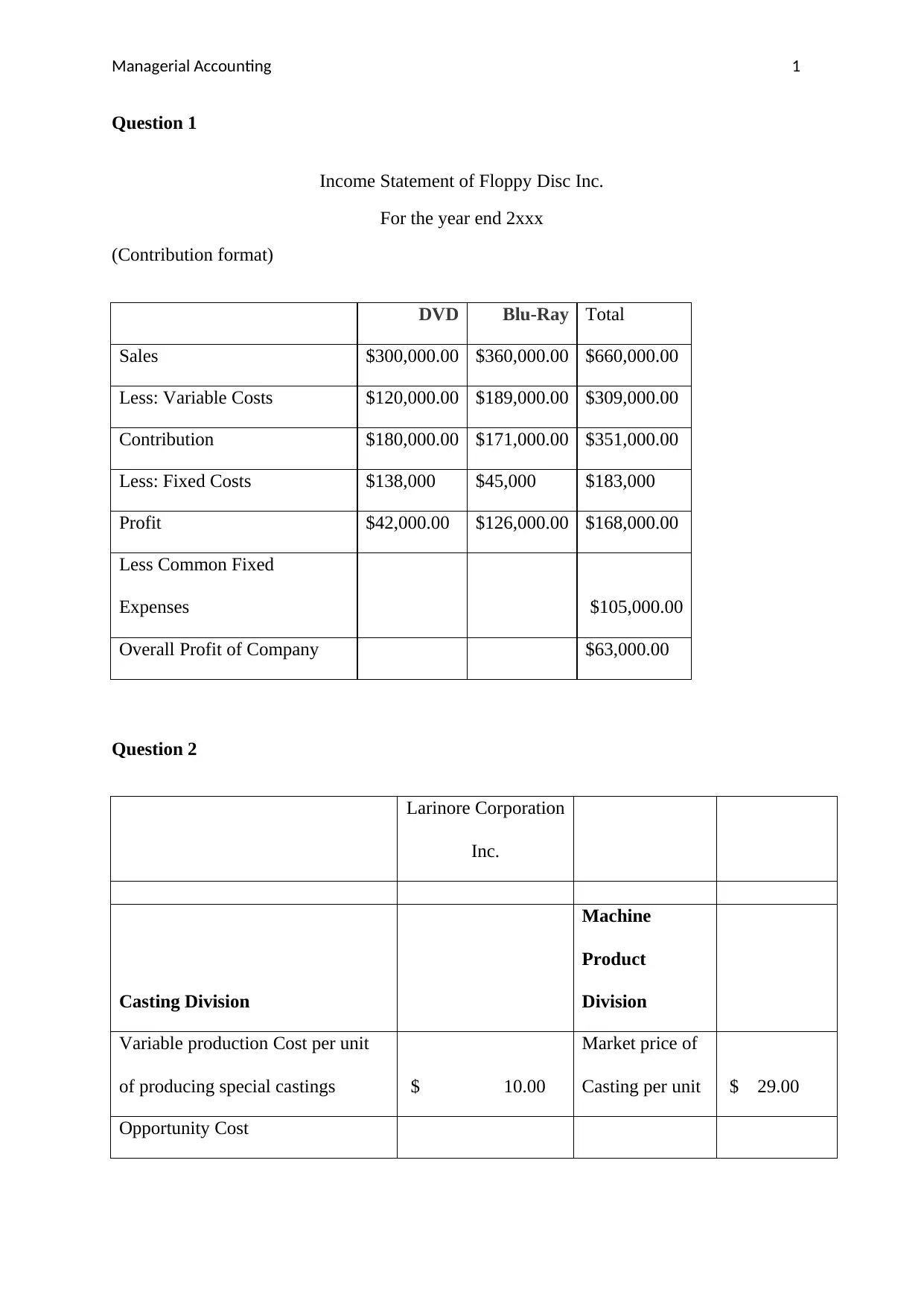
Managerial Accounting 1
Question 1
Income Statement of Floppy Disc Inc.
For the year end 2xxx
(Contribution format)
DVD Blu-Ray Total
Sales $300,000.00 $360,000.00 $660,000.00
Less: Variable Costs $120,000.00 $189,000.00 $309,000.00
Contribution $180,000.00 $171,000.00 $351,000.00
Less: Fixed Costs $138,000 $45,000 $183,000
Profit $42,000.00 $126,000.00 $168,000.00
Less Common Fixed
Expenses $105,000.00
Overall Profit of Company $63,000.00
Question 2
Larinore Corporation
Inc.
Casting Division
Machine
Product
Division
Variable production Cost per unit
of producing special castings $ 10.00
Market price of
Casting per unit $ 29.00
Opportunity Cost
Question 1
Income Statement of Floppy Disc Inc.
For the year end 2xxx
(Contribution format)
DVD Blu-Ray Total
Sales $300,000.00 $360,000.00 $660,000.00
Less: Variable Costs $120,000.00 $189,000.00 $309,000.00
Contribution $180,000.00 $171,000.00 $351,000.00
Less: Fixed Costs $138,000 $45,000 $183,000
Profit $42,000.00 $126,000.00 $168,000.00
Less Common Fixed
Expenses $105,000.00
Overall Profit of Company $63,000.00
Question 2
Larinore Corporation
Inc.
Casting Division
Machine
Product
Division
Variable production Cost per unit
of producing special castings $ 10.00
Market price of
Casting per unit $ 29.00
Opportunity Cost

Managerial Accounting 2
Selling Price of RB4 $ 30.00
Less: Variable Cost $ 12.00
Less : Boxing and Shipping Costs $ 4.00
Contribution per unit $ 14.00
Shipping Cost $ 1.00
Transfer Pricing must be at least $ 25.00
Maximum Transfer Pricing $ 29.00
Internal Transfers
Total Contribution Lost on 20000
units $ 280,000.00 (20000*14)
Additional Variable Cost $ 200,000.00 (20000*10)
Shipping Cost $ 20,000.00 (20000*1)
Total cost if the castings are bought
from internal department $ 500,000.00
Purchased Externally
Cost if castings are purchased from
outside $ 580,000.00 (20000*29)
In the present case, Larinore Corporation is operating its business through two divisions viz.,
casting division and machine product division. The output of casting divisions is used as an
input for the machine product division and hence this case related to the transfer pricing
system of management accounting. If the special castings that are produced by casting
department are transferred to the machine product department, the casting department will
Selling Price of RB4 $ 30.00
Less: Variable Cost $ 12.00
Less : Boxing and Shipping Costs $ 4.00
Contribution per unit $ 14.00
Shipping Cost $ 1.00
Transfer Pricing must be at least $ 25.00
Maximum Transfer Pricing $ 29.00
Internal Transfers
Total Contribution Lost on 20000
units $ 280,000.00 (20000*14)
Additional Variable Cost $ 200,000.00 (20000*10)
Shipping Cost $ 20,000.00 (20000*1)
Total cost if the castings are bought
from internal department $ 500,000.00
Purchased Externally
Cost if castings are purchased from
outside $ 580,000.00 (20000*29)
In the present case, Larinore Corporation is operating its business through two divisions viz.,
casting division and machine product division. The output of casting divisions is used as an
input for the machine product division and hence this case related to the transfer pricing
system of management accounting. If the special castings that are produced by casting
department are transferred to the machine product department, the casting department will
⊘ This is a preview!⊘
Do you want full access?
Subscribe today to unlock all pages.

Trusted by 1+ million students worldwide
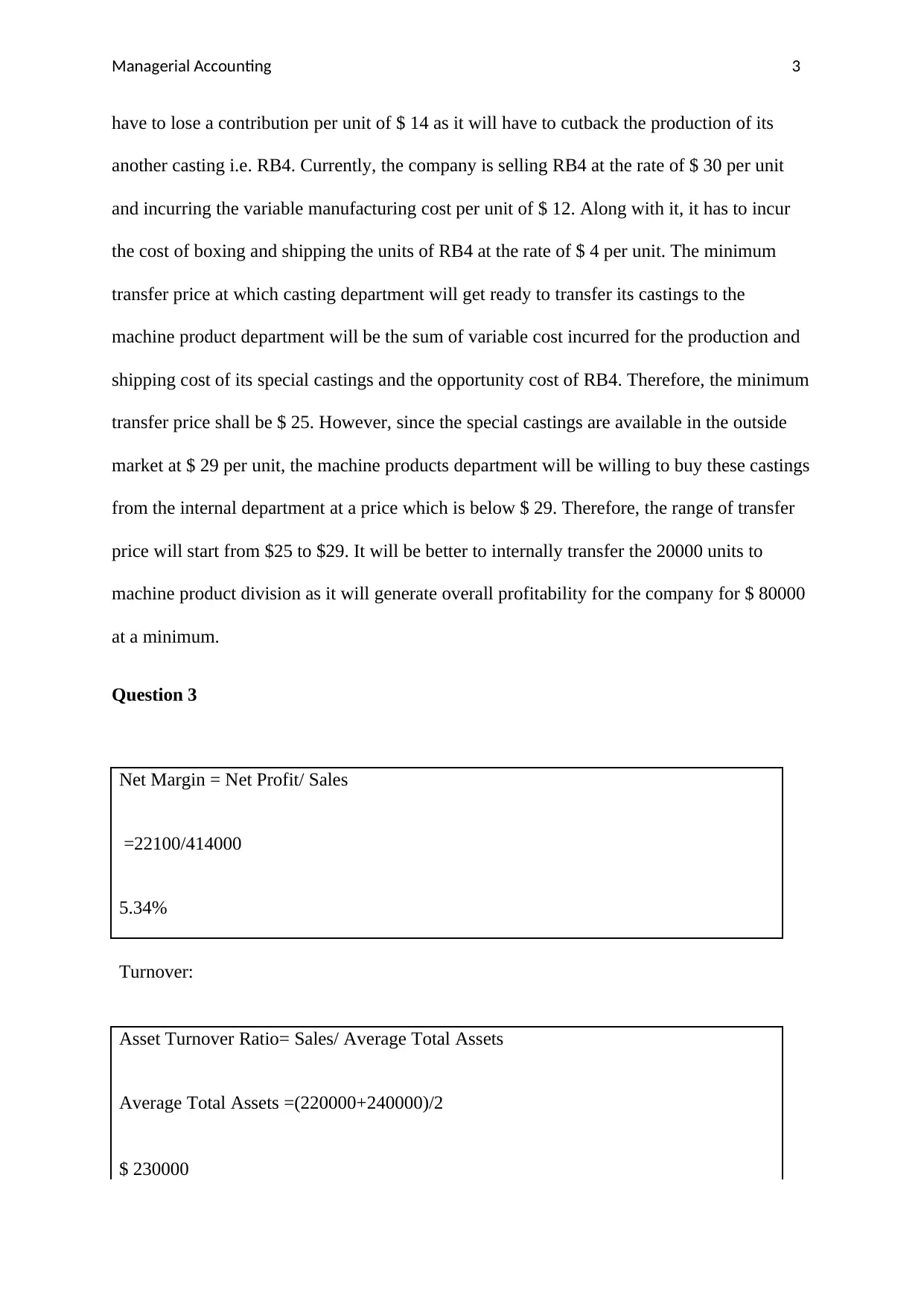
Managerial Accounting 3
have to lose a contribution per unit of $ 14 as it will have to cutback the production of its
another casting i.e. RB4. Currently, the company is selling RB4 at the rate of $ 30 per unit
and incurring the variable manufacturing cost per unit of $ 12. Along with it, it has to incur
the cost of boxing and shipping the units of RB4 at the rate of $ 4 per unit. The minimum
transfer price at which casting department will get ready to transfer its castings to the
machine product department will be the sum of variable cost incurred for the production and
shipping cost of its special castings and the opportunity cost of RB4. Therefore, the minimum
transfer price shall be $ 25. However, since the special castings are available in the outside
market at $ 29 per unit, the machine products department will be willing to buy these castings
from the internal department at a price which is below $ 29. Therefore, the range of transfer
price will start from $25 to $29. It will be better to internally transfer the 20000 units to
machine product division as it will generate overall profitability for the company for $ 80000
at a minimum.
Question 3
Net Margin = Net Profit/ Sales
=22100/414000
5.34%
Turnover:
Asset Turnover Ratio= Sales/ Average Total Assets
Average Total Assets =(220000+240000)/2
$ 230000
have to lose a contribution per unit of $ 14 as it will have to cutback the production of its
another casting i.e. RB4. Currently, the company is selling RB4 at the rate of $ 30 per unit
and incurring the variable manufacturing cost per unit of $ 12. Along with it, it has to incur
the cost of boxing and shipping the units of RB4 at the rate of $ 4 per unit. The minimum
transfer price at which casting department will get ready to transfer its castings to the
machine product department will be the sum of variable cost incurred for the production and
shipping cost of its special castings and the opportunity cost of RB4. Therefore, the minimum
transfer price shall be $ 25. However, since the special castings are available in the outside
market at $ 29 per unit, the machine products department will be willing to buy these castings
from the internal department at a price which is below $ 29. Therefore, the range of transfer
price will start from $25 to $29. It will be better to internally transfer the 20000 units to
machine product division as it will generate overall profitability for the company for $ 80000
at a minimum.
Question 3
Net Margin = Net Profit/ Sales
=22100/414000
5.34%
Turnover:
Asset Turnover Ratio= Sales/ Average Total Assets
Average Total Assets =(220000+240000)/2
$ 230000
Paraphrase This Document
Need a fresh take? Get an instant paraphrase of this document with our AI Paraphraser
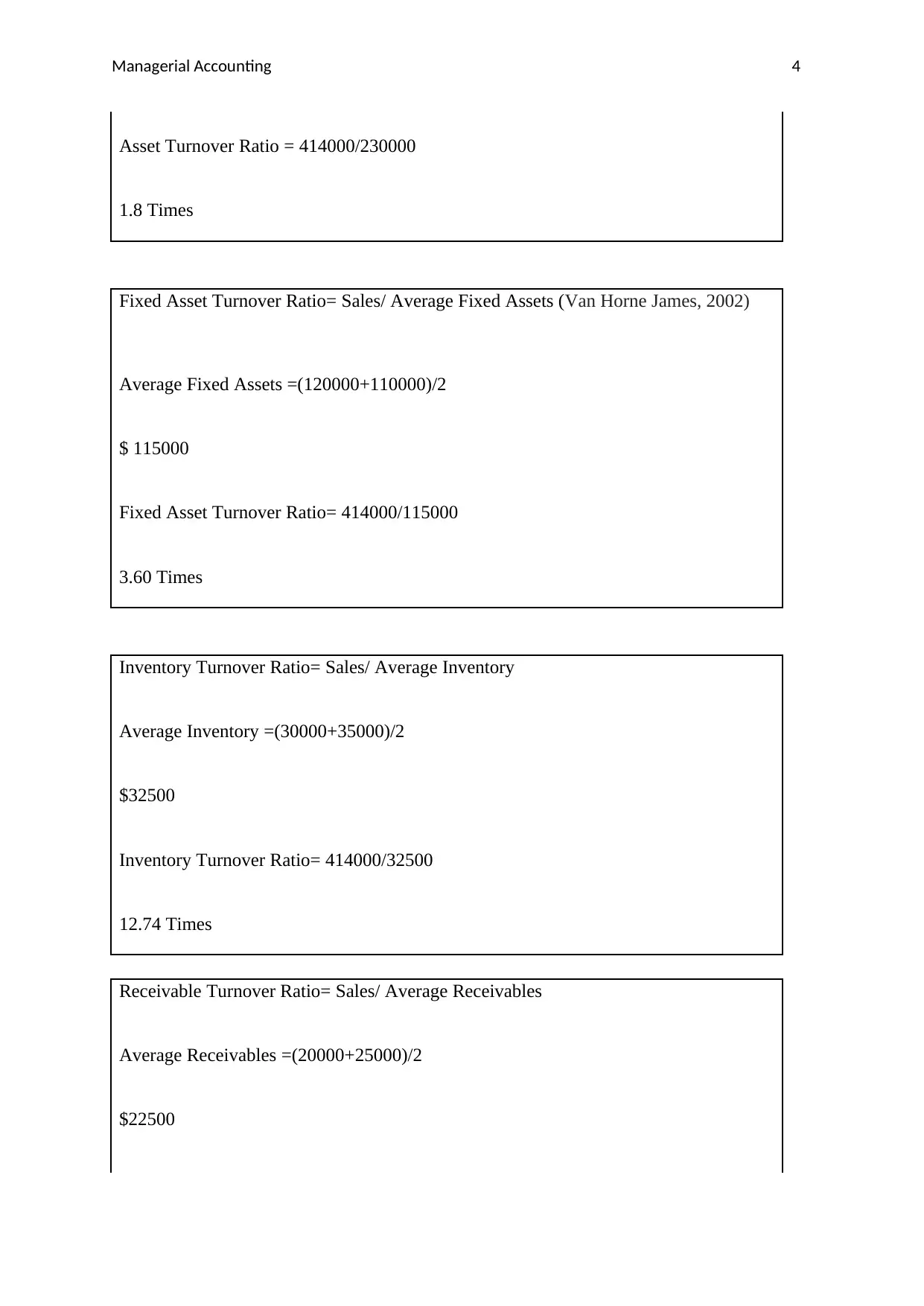
Managerial Accounting 4
Asset Turnover Ratio = 414000/230000
1.8 Times
Fixed Asset Turnover Ratio= Sales/ Average Fixed Assets (Van Horne James, 2002)
Average Fixed Assets =(120000+110000)/2
$ 115000
Fixed Asset Turnover Ratio= 414000/115000
3.60 Times
Inventory Turnover Ratio= Sales/ Average Inventory
Average Inventory =(30000+35000)/2
$32500
Inventory Turnover Ratio= 414000/32500
12.74 Times
Receivable Turnover Ratio= Sales/ Average Receivables
Average Receivables =(20000+25000)/2
$22500
Asset Turnover Ratio = 414000/230000
1.8 Times
Fixed Asset Turnover Ratio= Sales/ Average Fixed Assets (Van Horne James, 2002)
Average Fixed Assets =(120000+110000)/2
$ 115000
Fixed Asset Turnover Ratio= 414000/115000
3.60 Times
Inventory Turnover Ratio= Sales/ Average Inventory
Average Inventory =(30000+35000)/2
$32500
Inventory Turnover Ratio= 414000/32500
12.74 Times
Receivable Turnover Ratio= Sales/ Average Receivables
Average Receivables =(20000+25000)/2
$22500

Managerial Accounting 5
Receivable Turnover Ratio = 414000/22500
18.4 Times
Return on Investment = Net Income / Average Total Assets
=22100/230000
9.6%
Question 4
ROI Operating Income
Average Operating Assets
Parth 630000/3000000
21.00%
Darwin 1800000/10000000
18.00%
Residual
Income
Operating Profit - (Average Operating Assets *
Required Rate of Return)
Parth 630000-(3000000*16%) $150,000
Darwin 1800000-(10000000*16%) $200,000
Receivable Turnover Ratio = 414000/22500
18.4 Times
Return on Investment = Net Income / Average Total Assets
=22100/230000
9.6%
Question 4
ROI Operating Income
Average Operating Assets
Parth 630000/3000000
21.00%
Darwin 1800000/10000000
18.00%
Residual
Income
Operating Profit - (Average Operating Assets *
Required Rate of Return)
Parth 630000-(3000000*16%) $150,000
Darwin 1800000-(10000000*16%) $200,000
⊘ This is a preview!⊘
Do you want full access?
Subscribe today to unlock all pages.

Trusted by 1+ million students worldwide
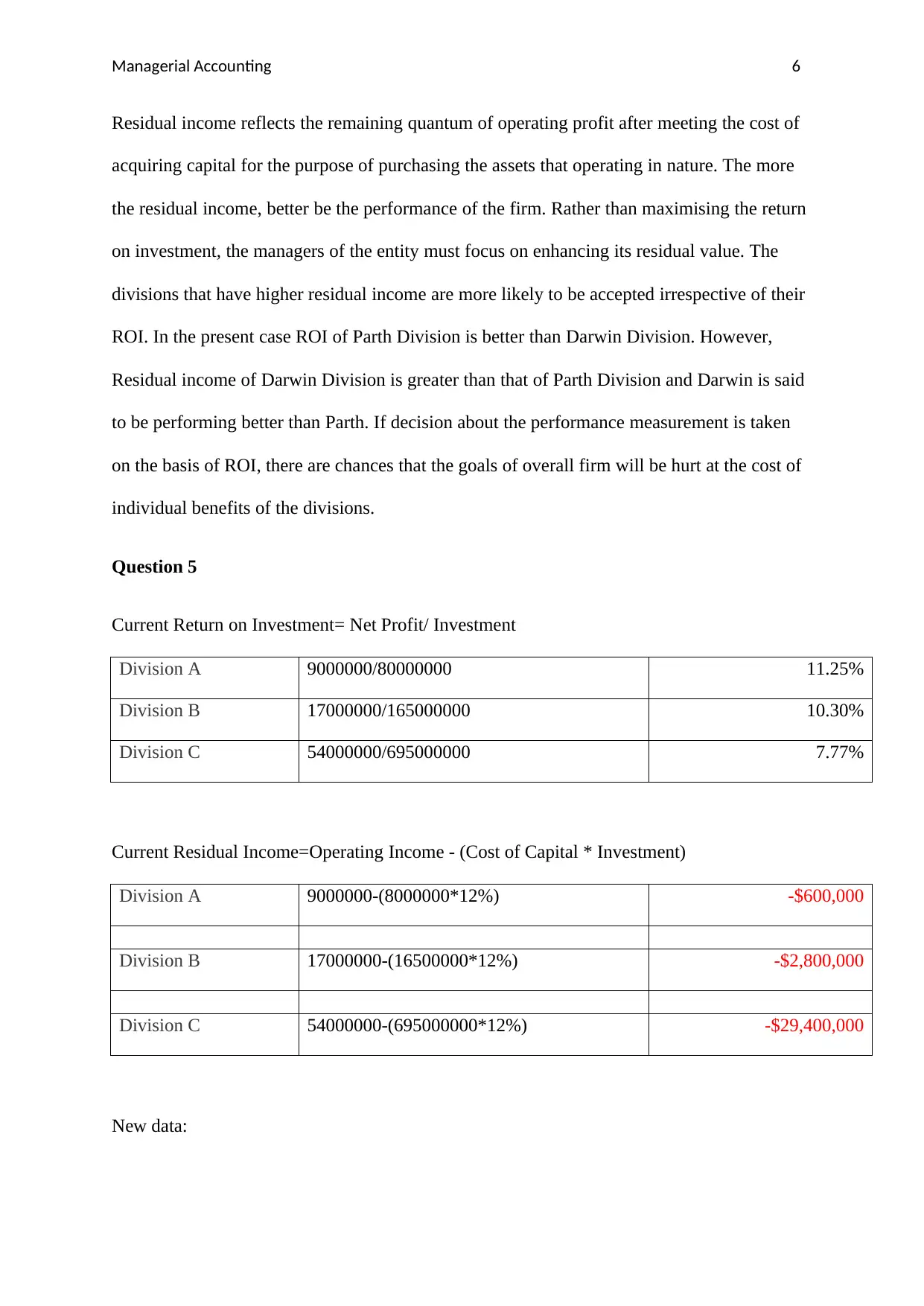
Managerial Accounting 6
Residual income reflects the remaining quantum of operating profit after meeting the cost of
acquiring capital for the purpose of purchasing the assets that operating in nature. The more
the residual income, better be the performance of the firm. Rather than maximising the return
on investment, the managers of the entity must focus on enhancing its residual value. The
divisions that have higher residual income are more likely to be accepted irrespective of their
ROI. In the present case ROI of Parth Division is better than Darwin Division. However,
Residual income of Darwin Division is greater than that of Parth Division and Darwin is said
to be performing better than Parth. If decision about the performance measurement is taken
on the basis of ROI, there are chances that the goals of overall firm will be hurt at the cost of
individual benefits of the divisions.
Question 5
Current Return on Investment= Net Profit/ Investment
Division A 9000000/80000000 11.25%
Division B 17000000/165000000 10.30%
Division C 54000000/695000000 7.77%
Current Residual Income=Operating Income - (Cost of Capital * Investment)
Division A 9000000-(8000000*12%) -$600,000
Division B 17000000-(16500000*12%) -$2,800,000
Division C 54000000-(695000000*12%) -$29,400,000
New data:
Residual income reflects the remaining quantum of operating profit after meeting the cost of
acquiring capital for the purpose of purchasing the assets that operating in nature. The more
the residual income, better be the performance of the firm. Rather than maximising the return
on investment, the managers of the entity must focus on enhancing its residual value. The
divisions that have higher residual income are more likely to be accepted irrespective of their
ROI. In the present case ROI of Parth Division is better than Darwin Division. However,
Residual income of Darwin Division is greater than that of Parth Division and Darwin is said
to be performing better than Parth. If decision about the performance measurement is taken
on the basis of ROI, there are chances that the goals of overall firm will be hurt at the cost of
individual benefits of the divisions.
Question 5
Current Return on Investment= Net Profit/ Investment
Division A 9000000/80000000 11.25%
Division B 17000000/165000000 10.30%
Division C 54000000/695000000 7.77%
Current Residual Income=Operating Income - (Cost of Capital * Investment)
Division A 9000000-(8000000*12%) -$600,000
Division B 17000000-(16500000*12%) -$2,800,000
Division C 54000000-(695000000*12%) -$29,400,000
New data:
Paraphrase This Document
Need a fresh take? Get an instant paraphrase of this document with our AI Paraphraser
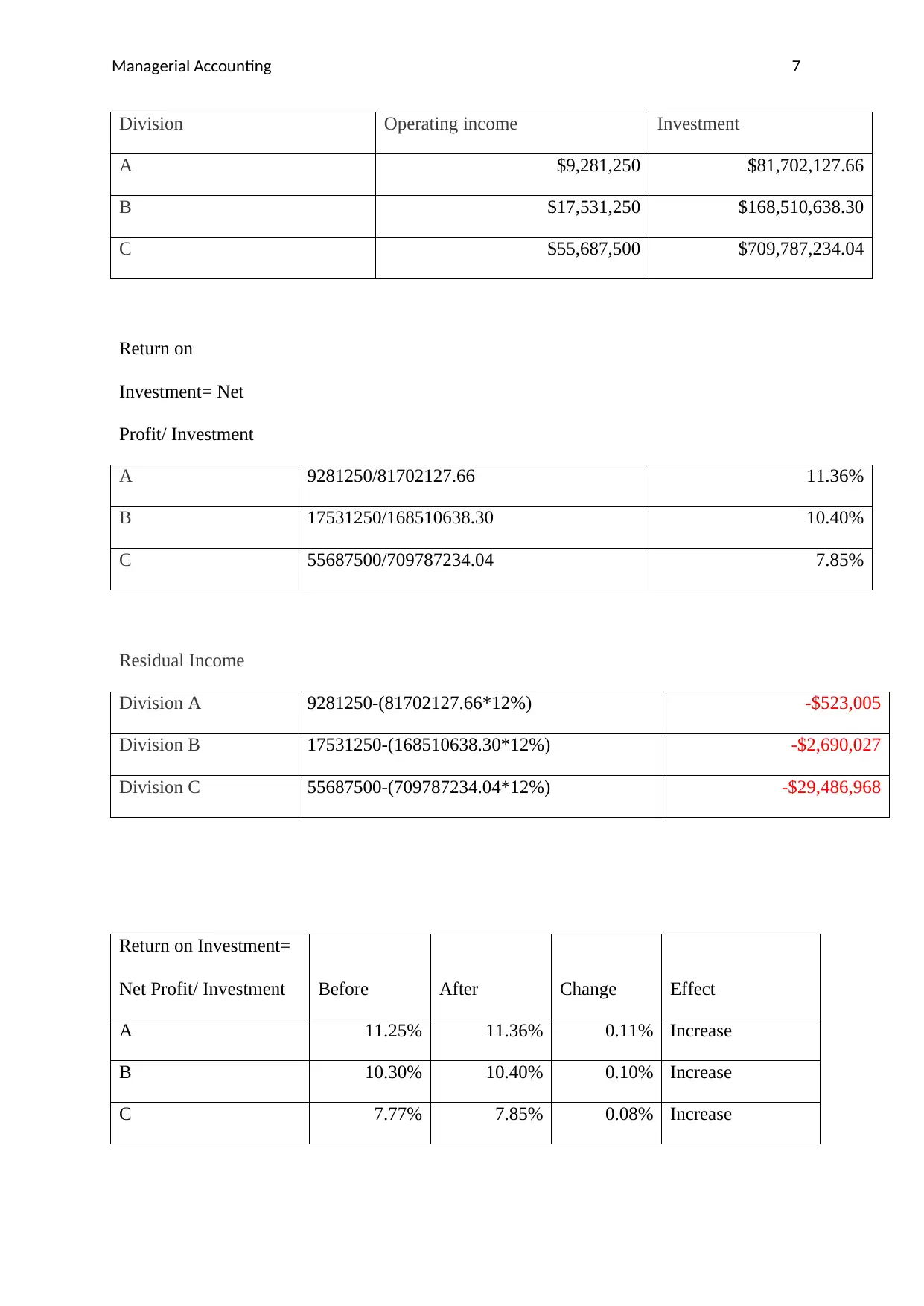
Managerial Accounting 7
Division Operating income Investment
A $9,281,250 $81,702,127.66
B $17,531,250 $168,510,638.30
C $55,687,500 $709,787,234.04
Return on
Investment= Net
Profit/ Investment
A 9281250/81702127.66 11.36%
B 17531250/168510638.30 10.40%
C 55687500/709787234.04 7.85%
Residual Income
Division A 9281250-(81702127.66*12%) -$523,005
Division B 17531250-(168510638.30*12%) -$2,690,027
Division C 55687500-(709787234.04*12%) -$29,486,968
Return on Investment=
Net Profit/ Investment Before After Change Effect
A 11.25% 11.36% 0.11% Increase
B 10.30% 10.40% 0.10% Increase
C 7.77% 7.85% 0.08% Increase
Division Operating income Investment
A $9,281,250 $81,702,127.66
B $17,531,250 $168,510,638.30
C $55,687,500 $709,787,234.04
Return on
Investment= Net
Profit/ Investment
A 9281250/81702127.66 11.36%
B 17531250/168510638.30 10.40%
C 55687500/709787234.04 7.85%
Residual Income
Division A 9281250-(81702127.66*12%) -$523,005
Division B 17531250-(168510638.30*12%) -$2,690,027
Division C 55687500-(709787234.04*12%) -$29,486,968
Return on Investment=
Net Profit/ Investment Before After Change Effect
A 11.25% 11.36% 0.11% Increase
B 10.30% 10.40% 0.10% Increase
C 7.77% 7.85% 0.08% Increase
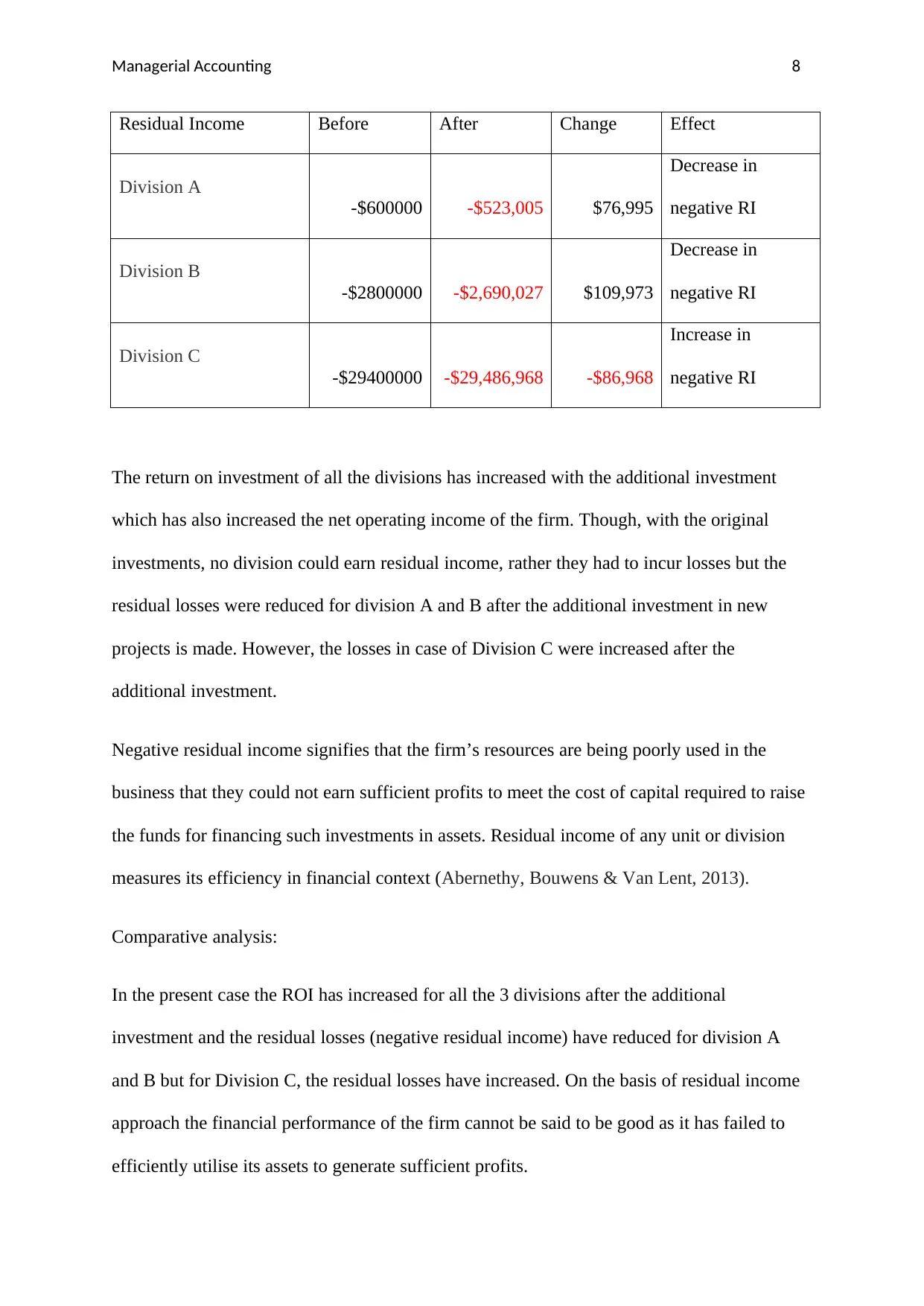
Managerial Accounting 8
Residual Income Before After Change Effect
Division A
-$600000 -$523,005 $76,995
Decrease in
negative RI
Division B
-$2800000 -$2,690,027 $109,973
Decrease in
negative RI
Division C
-$29400000 -$29,486,968 -$86,968
Increase in
negative RI
The return on investment of all the divisions has increased with the additional investment
which has also increased the net operating income of the firm. Though, with the original
investments, no division could earn residual income, rather they had to incur losses but the
residual losses were reduced for division A and B after the additional investment in new
projects is made. However, the losses in case of Division C were increased after the
additional investment.
Negative residual income signifies that the firm’s resources are being poorly used in the
business that they could not earn sufficient profits to meet the cost of capital required to raise
the funds for financing such investments in assets. Residual income of any unit or division
measures its efficiency in financial context (Abernethy, Bouwens & Van Lent, 2013).
Comparative analysis:
In the present case the ROI has increased for all the 3 divisions after the additional
investment and the residual losses (negative residual income) have reduced for division A
and B but for Division C, the residual losses have increased. On the basis of residual income
approach the financial performance of the firm cannot be said to be good as it has failed to
efficiently utilise its assets to generate sufficient profits.
Residual Income Before After Change Effect
Division A
-$600000 -$523,005 $76,995
Decrease in
negative RI
Division B
-$2800000 -$2,690,027 $109,973
Decrease in
negative RI
Division C
-$29400000 -$29,486,968 -$86,968
Increase in
negative RI
The return on investment of all the divisions has increased with the additional investment
which has also increased the net operating income of the firm. Though, with the original
investments, no division could earn residual income, rather they had to incur losses but the
residual losses were reduced for division A and B after the additional investment in new
projects is made. However, the losses in case of Division C were increased after the
additional investment.
Negative residual income signifies that the firm’s resources are being poorly used in the
business that they could not earn sufficient profits to meet the cost of capital required to raise
the funds for financing such investments in assets. Residual income of any unit or division
measures its efficiency in financial context (Abernethy, Bouwens & Van Lent, 2013).
Comparative analysis:
In the present case the ROI has increased for all the 3 divisions after the additional
investment and the residual losses (negative residual income) have reduced for division A
and B but for Division C, the residual losses have increased. On the basis of residual income
approach the financial performance of the firm cannot be said to be good as it has failed to
efficiently utilise its assets to generate sufficient profits.
⊘ This is a preview!⊘
Do you want full access?
Subscribe today to unlock all pages.

Trusted by 1+ million students worldwide

Managerial Accounting 9
Paraphrase This Document
Need a fresh take? Get an instant paraphrase of this document with our AI Paraphraser
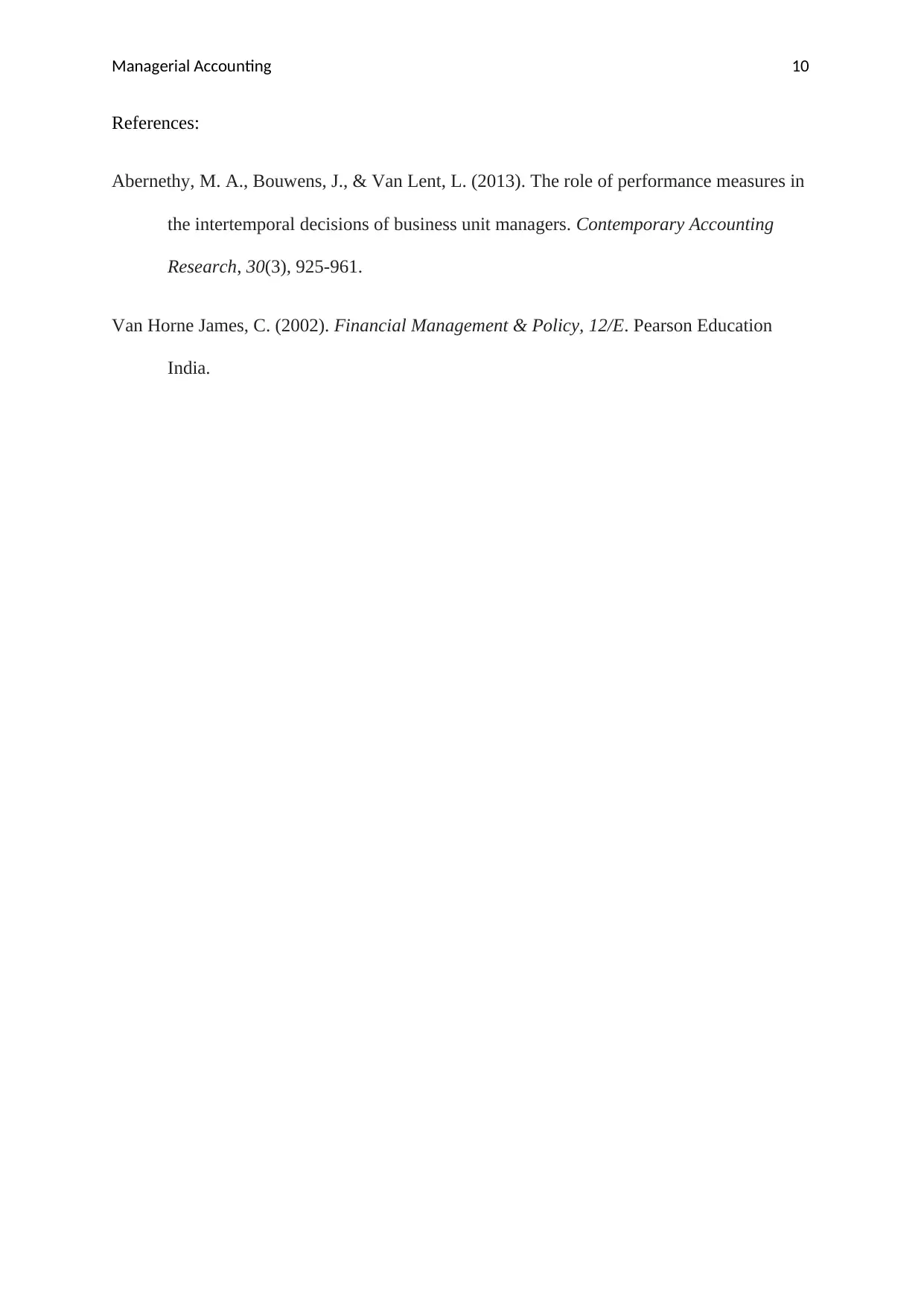
Managerial Accounting 10
References:
Abernethy, M. A., Bouwens, J., & Van Lent, L. (2013). The role of performance measures in
the intertemporal decisions of business unit managers. Contemporary Accounting
Research, 30(3), 925-961.
Van Horne James, C. (2002). Financial Management & Policy, 12/E. Pearson Education
India.
References:
Abernethy, M. A., Bouwens, J., & Van Lent, L. (2013). The role of performance measures in
the intertemporal decisions of business unit managers. Contemporary Accounting
Research, 30(3), 925-961.
Van Horne James, C. (2002). Financial Management & Policy, 12/E. Pearson Education
India.
1 out of 11
Related Documents
Your All-in-One AI-Powered Toolkit for Academic Success.
+13062052269
info@desklib.com
Available 24*7 on WhatsApp / Email
![[object Object]](/_next/static/media/star-bottom.7253800d.svg)
Unlock your academic potential
© 2024 | Zucol Services PVT LTD | All rights reserved.





